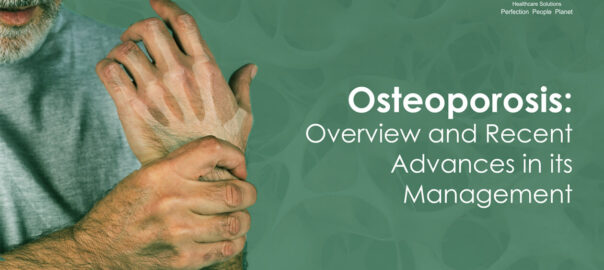Osteoporosis is a silent age-related skeletal disease characterized by loss of bone mineral density and microarchitectural deterioration leading to increased fragility and susceptibility to fractures. The most common sites of fracture are femoral neck, lumbar spine and distal forearm which more than often are debilitating and disabling if not intervened. Osteoporosis has affected more than 200 million people worldwide, with almost 8.9 million fractures reported annually across the globe. Close to 30% of postmenopausal women in America and Europe suffer from osteoporosis while India estimates not less than 50 million of its people in the plexus of this debilitating bone disease. The overall impact of osteoporosis is presented in Table 1.

Assessed by a T score of less than -2.5 (World Health Organization definition in Figure 1) and a Z score significantly higher or lower than the average, osteoporosis may operationally be classified as the following 2 types:
Postmenopausal (type I): Linked to the fall in oestrogen levels, this type affects women between 50 and 70 years of age.
Senile (type II): Affects both men and women over the age of 70, but predominantly women.

Risk Factors for Osteoporosis
Using Fracture Risk Assessment Tool Model (FRAX) algorithms, several risk factors have been recognized that predispose men and women to osteoporosis. Smoking, alcohol consumption, high salt intake, immobilization, sedentary life, excessive weight loss reducing the BMI below 18.5 kg/m2, inadequate exposure to sun and socioeconomic factors have been shown to be significantly associated with its risk and incidence. The most common risk factors are shown in Figure 2, of which, modifiable factors like declining levels of sex hormones, anorexia nervosa, low calcium and vitamin D intake are attributed to faulty lifestyle. Public awareness campaigns have been spreading their annex to educate and motivate necessary changes towards preventing osteoporosis.

RECENT ADVANCES IN OSTEOPOROSIS
Diagnosis
With one in three women and one in every five men over the age of 50 years worldwide are being estimated to face the risk of osteoporotic fractures in their lifetime [1], inclusion of diagnostic tests for bone health in their health check-up plans to help them get therapeutic or preventive measures in time becomes imperative.
- Dual energy X-ray absorptiometry (DXA): Stands as the gold-standard for diagnosis of osteoporosis by determination of bone mineral density (BMD). However, the high capital cost of DXA created a need for alternative diagnostic tools.
- Bindex®: Recently approved by United States Food and Drug Administration (USFDA) for osteoporosis diagnosis, it is a portable hand-held instrument that measures with 90% sensitivity and specificity, cortical bone thickness of the tibia. The algorithm calculates the density index, a parameter which estimates BMD at the hip as measured with DXA.
- OsCare Sono: This is another inexpensive and small portable ultrasound-based instrument that measures bone strength from the forearm radial bone. It provided measurement results in a few minutes and they correlate well with bone cortical thickness, bone elasticity and BMD, including BMD of the deeper cortical layers. These attributes suggest a promising device that offers enhanced sensitivity to early osteoporotic changes.
Treatment
Currently, to accost the imbalance between bone resorption and build-up in osteoporosis, anti-resorptive and osteoanabolic agents crown the list and fall under the first and second line of therapy [9].
- Bisphosphonates which bind to bone mineral and also inhibit bone osteoclast activity (resorption), are anti-resorptive agents which mainly increase the trabecular BMD and are one of the reliable and cost-effective first-line therapy options for both primary and secondary osteoporosis.
- Denosumab, a human monoclonal antibody, inhibits RANKL-induced bone resorption and increased cortical BMD.
- Teriparatide is an N-terminal 34-amin acid long peptide of the parathyroid hormone which again acts on increasing lumbar BMD and contributes to prevention of vertebral and non-vertebral fractures.
- Abaloparatide is again a peptide 34-amino acid long and belonging to the N terminal region of PTH-related protein. It has shown to be effective in increasing the lumbar spine- and proximal femoral BMD.
- Romosozumab, an anti-sclerostin humanized monoclonal antibody, is shown to increase the lumbar spine- and proximal femoral BMD.
Table 2 gives a brief glance over the current mediation used to treat osteoporosis with their trade names.

Apart from these current ones, there have been a surge in development of more efficacious drugs for osteoporosis management (Table 3).

A minimally invasive targeted treatment in which local bone loss due to osteoporosis is restored by implanting a unique material that is resorbed and replaced by bone, is being offered as Ossure LOEP (local osteo-enhancement procedure) kit by AgNovos, USA. Also, during the last decade, vertebroplasty and kyphoplasty has also evolved as an effective surgical procedure in certain cases with subacute pain, oedema and focal joint tenderness.
THE KNOWLEDGE-PRACTICE GAP
Despite path-breaking diagnostic and therapeutic advances, there exists a lacuna in their application and compliance. Osteoporosis stays unfortunately and vastly, underdiagnosed and undertreated, and identifying these gaps in patient care becomes indispensable. A few of them are listed below:
- Failure to follow screening guidelines for osteoporosis by physicians leading to erroneous assumptions and subsequent lack of appropriate treatment plan.
- Inefficacy to treat patients sustaining fragility fracture with a timely intervention reducing the likelihood of preventing future fractures. One of the commonly observed reason is concerns around side effects of drugs like bisphosphonates, etc. which lead to reluctance from physicians in prescribing medicines and challenges in compliance by patients.
- Underestimating the menace of osteoporosis especially by women who are more at risk but are unfortunately lesser concerned about its consequences; poor communication with physicians and non-compliance of screening and diagnostic recommendations puts patients at irreversibly damaging risks.
- Inadequate follow-up and non-adherence by patients during the treatment regimen.
- Insufficient funding and reimbursement of exorbitant diagnostic and therapy costs also remaining one of the main reasons why osteoporosis lies low on the priority list of patients.
PREVENTION
Rebuild. Refuel. Renew.
Although lifestyle choices, genetics and systemic diseases, and even certain medications pose as substantial risk factors, the good news is that osteoporosis is preventable.
- Weight bearing and cardiovascular exercises: These not only work towards building muscles, but also strengthen bones, ligaments and tendons. In turn they improve agility, strength, balance and posture, considerably reducing the risks of fractures.
- Dietary calcium and vitamin D3 intake: Falling on the fundamentals of skeletal science, calcium and vitamin D stay incontestable for bone health. A good balanced diet and adequate exposure to sun are always the safest choices to regulate calcium and vitamin D3 levels,
- Supplements: calcium and vitamin D3 supplements are also often opted in times of nutritional inadequacy. Yet, concerns over prolonged supplementation causing serious adverse effects like hypercalcemia and hypercalciuria, have been cropping up lately. The U.S. Preventive Services Task Force (USPSTF) recently recommended “against daily supplementation with 400 IU or less of vitamin D3 and 1,000 mg or less of calcium for the primary prevention of fractures in noninstitutionalized postmenopausal women”.
“A thousand tiny steps can conquer the tallest tower”
Turacoz Healthcare Solutions aims to provide information on the latest trends, updates and advances in the field of clinical research, trials and regulatory affairs. Turacoz Healthcare provides an end-to-end support for scientific communications, clinical trial documents and disclosures, regulatory documents writing and submissions, and medico-marketing writing along with e-modules & e-books on healthcare and research.






